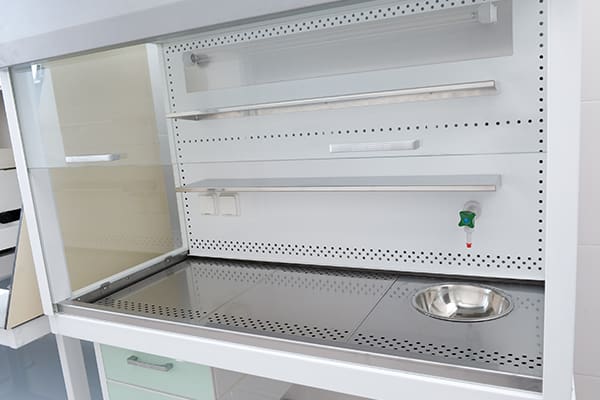01. Asbestos Use in Lab Equipment
Why Was Asbestos Used in Lab Equipment?
For most of the 20th century, companies made lab equipment with asbestos because the mineral is resistant to heat and damage. This made it useful in lab work involving high temperatures and corrosive elements. Equipment like fume hoods, fire blankets and countertops were made with asbestos.
Various industries, medical disciplines and schools used asbestos lab equipment. These tools helped many people in their research, product development and education, including:
- Biologists
- Dentists
- Engineers
- Microbiologists
- Physicians
- Physicists
- Students
- Teachers
Before the 1980s, people faced exposure while using or installing asbestos lab equipment. The risk of exposure still exists today. Companies have stopped using asbestos to manufacture lab equipment. But old asbestos products may still be present in laboratory settings.
Asbestos-Containing Lab Equipment History at a Glance
- Other Names: Lab furniture, lab instruments, lab supplies, laboratory equipment, scientific equipment
- Years of Manufacture: 1900s – 1980s
- Military Use: Research and testing laboratories
- Places Used: Autoclaves, countertops, fire blankets, fume hoods, gauze mats, gloves, heat mats, ovens
- Asbestos Use Banned: No
- Noteworthy Brands: Thermo Fisher Scientific, Kewaunee Scientific Corporation, Van Waters & Rogers Inc.
Asbestos exposure can cause people to develop cancers like mesothelioma and lung cancer. People who worked with asbestos lab equipment can discuss their exposure with doctors. Medical professionals can help them watch for signs of asbestos diseases.
02. List of Lab Equipment With Asbestos
List of Asbestos-Containing Lab Equipment
Companies used asbestos in a variety of lab equipment. Conducting high-temperature experiments increases the danger of fire, explosion and chemical exposure. Asbestos’ heat resistance and strength made it a useful addition to many products used in laboratories.
Some types of lab equipment, like fume hoods, heaters and sterilizers, contained asbestos cement. People may see asbestos cement referred to as “transite” on labels and in product catalogs.
Examples of asbestos-containing laboratory equipment include:
- Autoclaves
- Centrifuges
- Cloths
- Cords
- Countertops
- Crucibles
- Desktop/tripod mats
- Fire blankets
- Fire suits
- Fume hoods
- Gauze mats (heat mats)
- Gloves
- Heaters
- Insulation
- Kilns
- Mittens
- Ovens
- Papers
- Pipes
- Stand clamps
- Sterilizers
- Tapes
- Tongs
- Tubing
- Water baths
- Wires
Many companies made and supplied asbestos-containing lab equipment before the 1980s. Their catalogs often included “asbestos” in their product names.
In addition to people who used the products, employees at these asbestos companies also faced exposure risks. Any level of exposure is dangerous and can cause asbestos diseases to develop.
03. Lab Equipment & Asbestos Exposure
Who Is at Risk of Asbestos Exposure From Lab Equipment?
People who worked around lab products may have experienced occupational asbestos exposure. Asbestos lab products put workers at manufacturing, research and educational jobsites at risk. Workers who installed and repaired lab products also faced exposure.
Veterans may have faced exposure in lab settings. Asbestos use was common in the military for much of the 20th century. Different military branches maintain their own research facilities. Veterans may have come into contact with asbestos equipment in these facilities. The U.S. Department of Veterans Affairs offers benefits to veterans with asbestos diseases.
Some asbestos workers may not know which products caused their exposure. Asbestos diseases like mesothelioma often develop a long time after a person ingests or inhales the mineral. Mesothelioma lawyers can help identify asbestos-containing lab equipment that workers may have used.
Patients and family members may be able to file asbestos lawsuits. Successful lawsuits result in financial compensation. Lawyers can handle the lawsuit process and file veterans benefit claims on behalf of asbestos victims.
04. Asbestos-Containing Lab Equipment Removal
Safely Removing Asbestos-Containing Lab Equipment
Old lab equipment in classrooms and school laboratories may contain asbestos. Removal of these items is subject to state and federal asbestos laws and regulations. Some colleges and universities also have their own safety and removal procedures. School asbestos programs can help to protect students, teachers and others from exposure.
Some schools have guidelines that outline ways to avoid exposure on campus. For example, Stanford University warns against cutting or drilling into potential asbestos products. The university has identified lab countertops on campus that could release asbestos if disturbed.
Professionals should handle asbestos removal and disposal. Anyone who believes their laboratory equipment may contain asbestos should report their suspicions to the building manager. They can coordinate testing or abatement with asbestos professionals. The building manager may also contact the state’s environmental agency.



